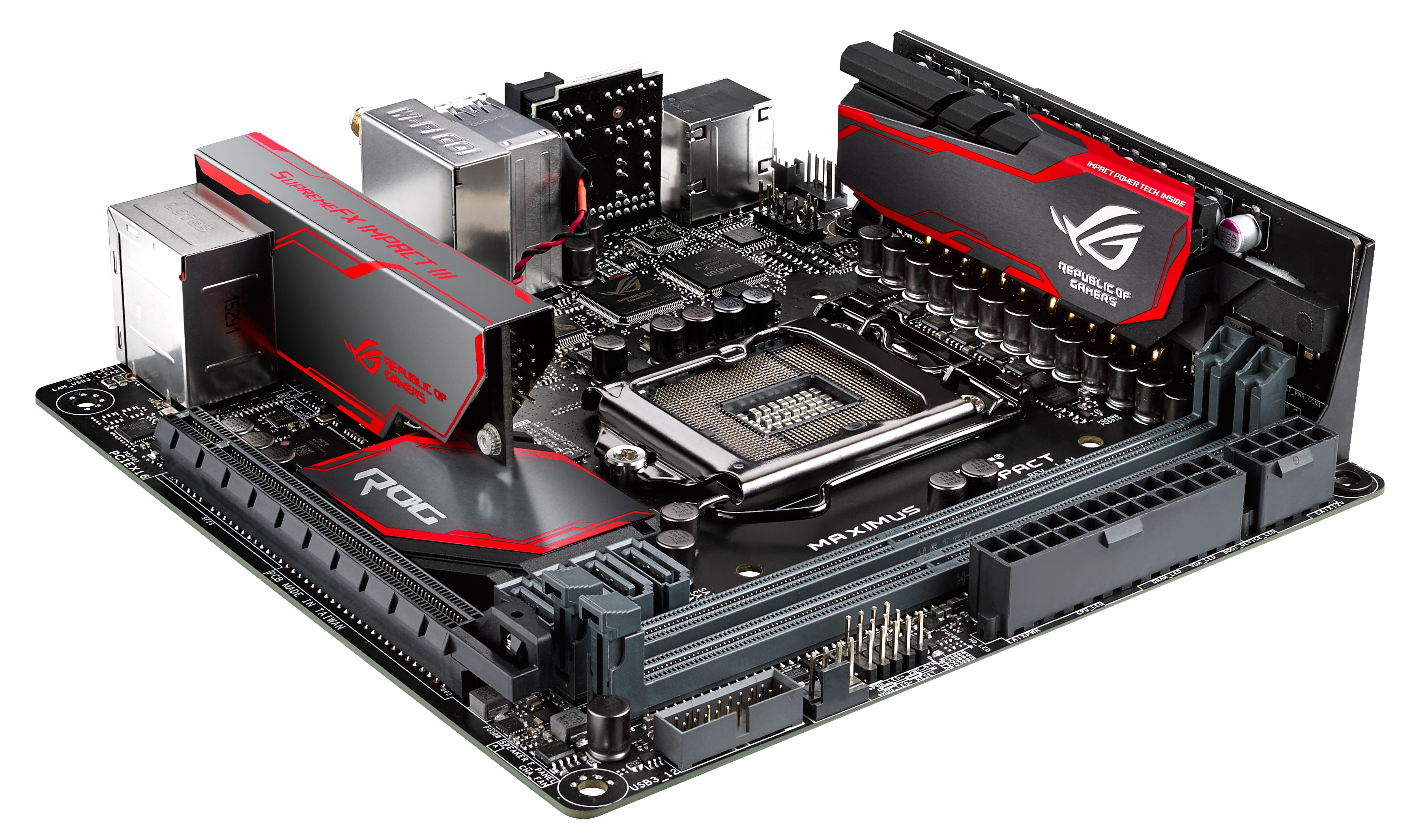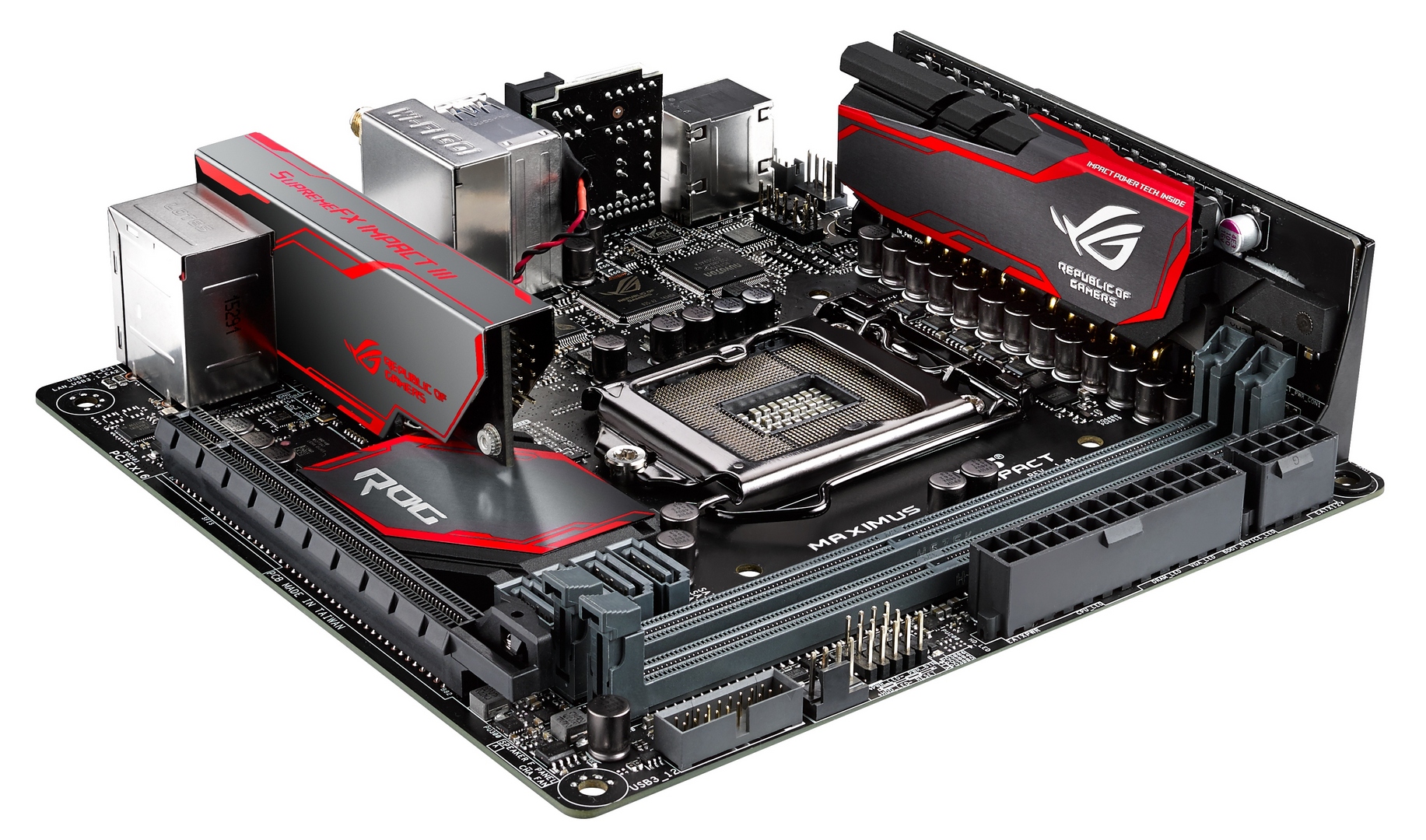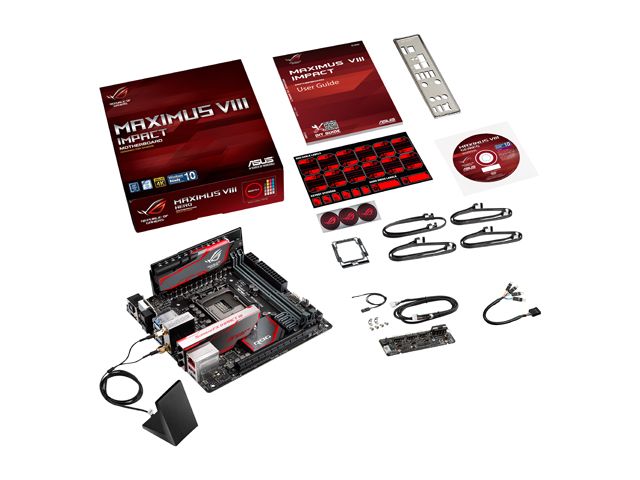The ASUS Maximus VIII Impact Z170 ROG Mini-ITX Motherboard Review
by Ian Cutress on December 29, 2015 9:00 AM ESTASUS Maximus VIII Impact Conclusion
The ROG line is a long standing brand of ASUS, approaching its 10 year anniversary in 2016. At CES during the early part of January, we are syncing up with AnandTech's senior motherboard editors from the last decade for a round table mixed with readers’ questions on the Republic of Gamers. Part of that discussion will be directed to the ROG Impact motherboard line, in which ASUS essentially stands alone in the premium Mini-ITX form factor market.
But therein lays a crucial part of the discussion. The Impact is premium; matching the price of a mid-to-high ATX sized motherboard while providing less expandability. In order to counteract this, the Mini-ITX product had to offer something more than the small size, and ASUS has done this over the Maximus VI, VII and now the latest VIII version. All of these have been award winning in various ways due to a high level of engineering prowess, but also a lack of competition in that premium space. The Mini-ITX form factor, although an exciting topic, is only a small chunk of the market, and perhaps gets a disproportionate amount of attention.
So if you're the sole premium player in a market, and the product is successful, how do you innovate each generation? On some level you can't keep adding or upgrading parts, purely due to space constraints and rising cost. Each generation has to offer something new - either hardware or software. In some respects the Z170 chipset takes care of this: DDR4, PCIe storage through U.2, and the move to USB 3.1.
But what ASUS specific improvements are there? The SupremeFX audio gets a full on EM shield to reduce external sources of noise, and it also gets internal LEDs making it easier to see where the ports are in a dark environment behind the system. Some may see this as an easy gimmick, but others will find it useful. We also had a great overclocking run, hitting 4.8 GHz at only 1.375 volts in the BIOS. As for DPC Latency, the Impact sits as the best board we've ever had, showing that on some level ASUS is keeping DPC Latency as a mental note during design.
On performance, the Impact implements MultiCore Turbo, which increases power consumption at default frequencies but puts CPU performance ahead of motherboards with MCT disabled on anything that can use multiple threads. In our benchmarks, all the CPU results are #1 for the Impact, the audio results of the Impact come out on top of all the motherboards we have tested, and the aforementioned DPC Latency is great. One downside on the BIOS we tested (v1101) was POST time, coming in at over 20 seconds. Aside from this, the BIOS and Software tools (which includes items such as RAMCache, RAMDisk, GameFirst III and Free Space) mark an ever evolving platform.
The main competition for the Impact comes from ASUS’ mainstream motherboard line, and the mini-ITX models, which have many of the features of the Impact except U.2, daughterboards and ROG software, but is also cheaper. Or any sub-$160 mini-ITX motherboard with ‘gaming’ in the name can offer similar stock performance for much less cost. When it comes to high priced motherboards, it comes down to the value-adds, and it becomes a user-focused question as to how many will be used. Playing Devil’s Advocate, something like U.2 could arguably be used via an M.2 to U.2 converter on other mini-ITX boards, and not a lot of users are enthused by onboard audio these days. Either Thunderbolt 3 support, or HDMI 2.0 through the Alpine Ridge as an LSPCON, could have put the Impact far over the edge for premium. But over the years, we’ve reviewed the Maximus VI Impact, the VII Impact and now the VIII Impact . Reading through those reviews, they all have sat at the top of the mini-ITX motherboard stack for both price but also feature set, and the Impact line has become difficult to ignore when building a premium small system. The extra features on the Impact are certainly worth the increased cost, but it’s all a question of use. Thankfully, when we did use it, it came top in pretty much all our system/CPU benchmarks in our Z170 motherboard testing so far, and that is quite hard to ignore.

Recommended by AnandTech
The ASUS Maximus VIII Impact














42 Comments
View All Comments
FelixDraconis - Wednesday, December 30, 2015 - link
Agreed with Mr. Elmore, but let me clarify. I'm a game programmer, myself. No, I do not have a college degree. I started too early for that. Writing clean documentation for others is one of the most important things I strive for. Picking good metaphors is also of vital importance. All things very similar to writing tech articles.Sure, some of my comments may be pedantic, but I'd rather have feedback than silence from my audience. I just hope that Mr. Ian will ponder them and decide to improve. We stop living when we stop learning. Anyway, I really just wanted to help. Anandtech is one of the best websites out there for tech articles and probably a great career builder.
Personally speaking, I stopped reading the text because it was hard to decipher. So, I suspect others would, too. Kind of defeats the purpose of writing it. Good luck, Mr. Ian!
mapesdhs - Wednesday, December 30, 2015 - link
Felix, personally I find your comments most welcome, better writing should be encouraged. Brevity is in short supply these days.SpartyOn - Tuesday, December 29, 2015 - link
I'm waiting for Nvidia Pascal to drop before updating my mini ITX Asus P8Z77-i Deluxe Ivy Bridge system. This review will heavily influence my opinion when it comes time to purchase. Looks pretty good to me.TheSlamma - Tuesday, December 29, 2015 - link
Ugh, Killer network cards SUCK Intel all the way homejasonelmore - Tuesday, December 29, 2015 - link
Asus never use Killer network cards, that's a MSI thing.. All Asus ROG boards use Intelmapesdhs - Wednesday, December 30, 2015 - link
I bought an MSI gaming laptop which has Killer E2400/wifi, works very well IMO. Far better wifi range than I've ever had before with a laptop, good GigE speeds too.mapesdhs - Wednesday, December 30, 2015 - link
Back in the Z97 era, I was pondering a Maximus VII IMPACT, but in the end I bought the ASUS Z97I-Plus instead, and very happy I am with it too. Many of the same features, cheaper, etc.Reading this article, I wondered if there was a S1151 equivalent; well, almost, namely the H170I-PLUS D3. Ian, Iike these top-end miniITX reviews, but it'd be nice to compare to something a bit further down the range. Afterall, the M8I doesn't have M.2, whereas the Z97I-Plus, and the newer H170I-Plus D3 both do have it, so the latter is surely worth of consideration.
mapesdhs - Wednesday, December 30, 2015 - link
(rats, still no edit function! Can we please make that a priority for AT in 2016? I meant to say, I like these top-end miniITX reviews, etc.)legolasyiu - Tuesday, January 5, 2016 - link
Ian, I bet your POST time will be better if you upgrade BIOS to 1302,Maximus VIII Impact BIOS 1302
1. Improve system stability
Visual - Wednesday, January 6, 2016 - link
Fun times, when "low end" gets to run 30fps on ultra, be it on a "low" resolution (that's still classified as HD, mind you).And the cherry on top is that even IGPs can finally do that, now if only they actually were put into some products... I wonder, why Intel seems to be purposely hiding the good Iris chips?